You Could Be Bringing Snakes Inside If You’re Not Checking This “Scary Place”
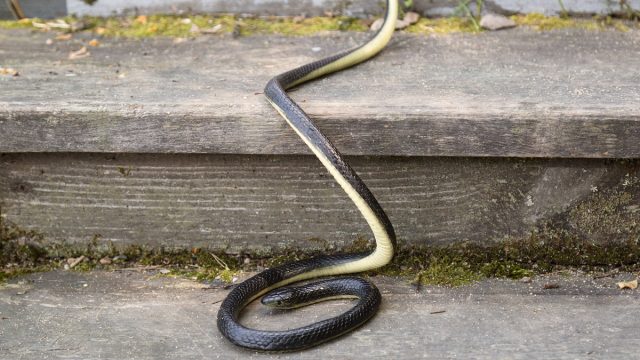
It’s fairly common knowledge that snakes like to hide out in places like piles of wood, dank basements, and even behind kitchen appliances. But a recent social media video exposes an entirely new and unexpected place where these slithery reptiles may be lurking near your home—and considering it’s high snake season, you may want to take note. Keep reading to find out the “scary place” you should be checking for snakes, as well as some other odd locales where these creepy crawlers have been found.
READ THIS NEXT: The No. 1 Way to Keep Snakes From Getting in Through Your Toilet.
Snakes like dark, hidden places.
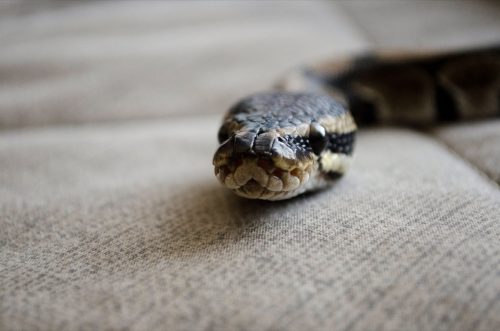
If you’re wondering why snakes have their preferred hiding spots, there are a few things to keep in mind. First, snakes are cold-blooded, meaning they can’t regulate their own body temperature. In the summer, they’re often looking for somewhere cool, and vice versa in the winter. They can get warm behind appliances or cool on the tiled floors of a bathroom.
Second, snakes, like all living creatures, need to eat. Places with food scraps or prey such as mice, rats, and insects will all attract snakes.
The third reason snakes will hibernate somewhere is that it’s secluded. “Snakes love to curl up in dark, out-of-the-way places,” Jennifer Mecham, a snake expert and writer with ReptilesBlog.com, previously told Best Life. Therefore, basements and attics are common places to find snakes, as are piles of clothes or messy rooms.
That’s why this “scary place” isn’t so strange.
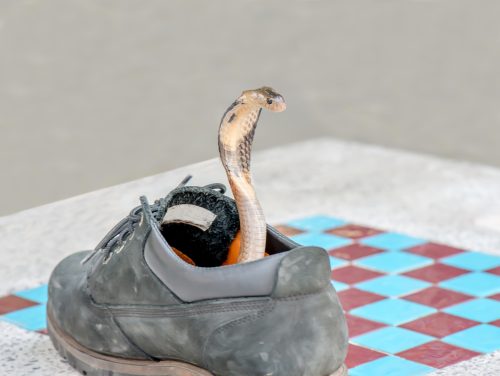
In a recent TikTok video that has nearly 300,000 likes and more than 3,000 shares, Southern California snake relocation pro Bruce Ireland of Snake Wranglers shared how he was called to a client’s house who found a snake in a pair of his running sneakers that he left outside his front door.
The scary part is that the snake wasn’t immediately visible. Ireland took a long metal hook and shook the sneaker to reveal the snake hiding in the covered toe portion of the shoe—and it just so happened to be a venomous rattlesnake.
In the comments, a user asked Ireland what would have happened if the client had put his foot in the shoe. “A bite would have occurred for sure,” he responded.
If you live in a place where snakes are common, never leave your shoes outside. And even if you live in a less snake-prone area, it’s probably still a good idea to bring your footwear inside since you never know what kind of reptile or rodent may be looking for shelter.
And why snakes love kitchen cabinets.
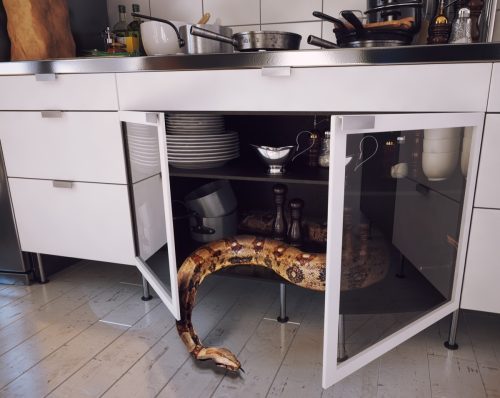
In another video, this time on YouTube, Ireland says he got a call from a woman who left her sliding door open for the dogs and came home to a snake in the kitchen.
By the time Ireland arrived, the snake had slithered through a tiny hole where the cabinets meet the floor. The crew had to drill into the cabinets in three places to get at the 70-inch snake, which promptly disappeared behind the cabinetry and then behind the fridge. After pulling the appliance out, Ireland was able to capture the snake.
As well as laundry rooms.
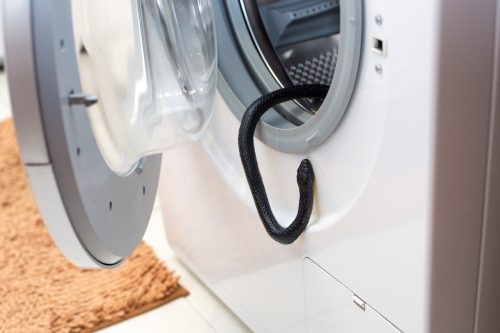
Alex Woollam, founder and CEO of Waterline Plumbing shared with Best Life how he found a snake in a washing machine while on a job.
“It was a nightmare, and as someone who is repairing washing machines, it has created trauma for me,” Woollam says. “Since that day, I have had an extra safety procedure before opening the machine door. I always use a flashlight to ensure I am not in for a surprise.”
Snakes are known to hide in laundry rooms, so do be careful if you think you may have invited one in. And overall, remember that snakes prefer less-obvious spots.
“Any nooks and crannies that aren’t being frequently cleaned, visited, or otherwise messed with could be a potential hideaway for a snake,” says Charles van Rees, conservation scientist and editor-in-chief of Gulo in Nature. “Some places I’ve heard of snakes being found include boots (we told you!), radiators, various parts of cars (wheel wells, under the hood), cupboards, attics and basements, and airplane landing gear.”